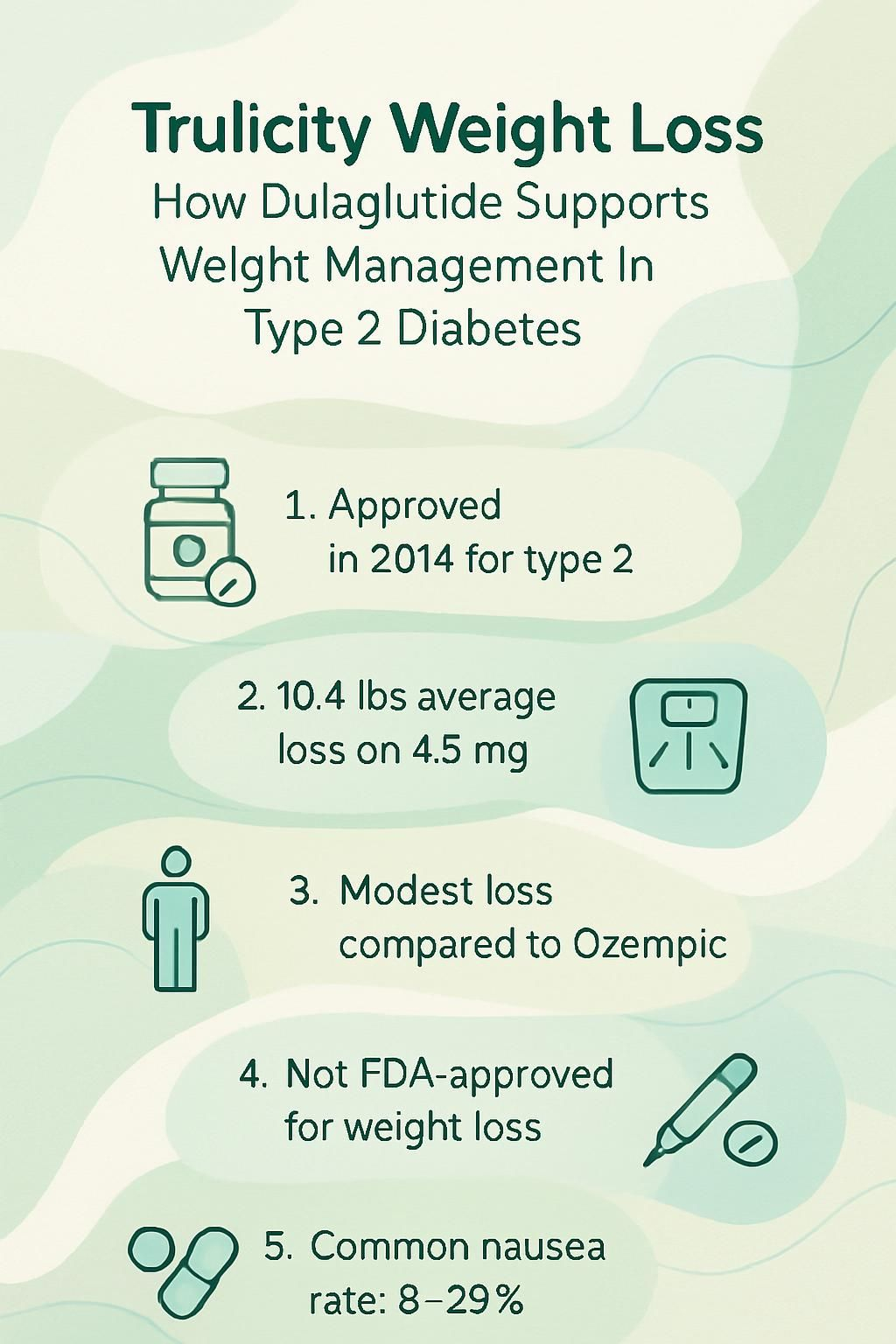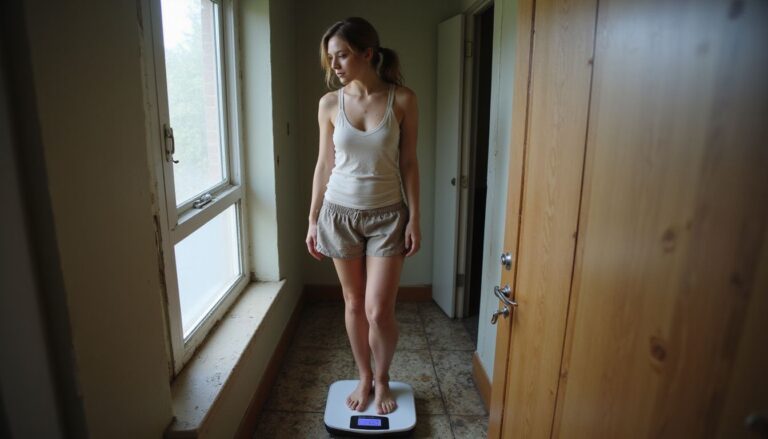Trulicity Weight Loss: How Dulaglutide Supports Weight Management In Type 2 Diabetes
Our Nutrition Assistant AI Suite will transform your body. You will lose fat, get toned, and build muscle. Gain confidence and optimal health.
If you have type 2 diabetes and find weight loss hard, you are not alone. Trulicity can help control blood sugar and may lead to steady weight loss in many adults with type 2 diabetes.
This article explains how Trulicity works, what studies show, typical side effects, and dose options. You will also see tips that help you get the best results while staying safe.
Keep reading to decide if this once-weekly medicine fits your plan.
Key Takeaways
- Trulicity (dulaglutide), a once-weekly GLP-1 receptor agonist, was FDA-approved for type 2 diabetes on September 18, 2014 and supports both blood sugar control and weight management.
- Clinical studies such as AWARD-11 show that patients using Trulicity 4.5 mg lost an average of 10.4 lbs over 52 weeks; lower doses resulted in less weight loss.
- Trulicity is not FDA-approved for weight loss but is commonly prescribed off-label for this purpose in people with type 2 diabetes who need extra support managing obesity.
- Common side effects include nausea (8–29%), diarrhea, or injection site reactions; rare but serious risks are thyroid C-cell tumors and pancreatitis per FDA boxed warning.
- Compared to Ozempic (semaglutide), which can lead to about a 15% body weight reduction over 68 weeks, Trulicity typically results in more modest yet steady long-term weight loss.

What is Trulicity?

Trulicity is a prescription medicine for adults with type 2 diabetes. You inject it once a week to improve blood sugar levels and it may support weight loss over time.
What is Dulaglutide and how does it work?
Dulaglutide is a GLP-1 receptor agonist, a drug that copies the action of a natural gut hormone called GLP-1. You inject it under the skin of the abdomen, thigh, or upper arm using a prefilled pen.
It helps your pancreas release insulin when blood sugar rises and lowers glucagon, a hormone that raises sugar. This combination smooths day-to-day glucose levels and lowers highs after meals.
The medicine has a half-life near five days, so one dose works in your body for about a week. Steady action from week to week makes dosing simple.
Dulaglutide also slows how fast food leaves your stomach. Feeling full longer often leads to fewer calories, smaller portions, and gradual weight loss.
Many adults notice better blood sugar control and a helpful weight change. Trulicity is FDA-approved for diabetes treatment, and some clinicians also prescribe it off-label for weight loss in select cases.
When was Trulicity approved by the FDA for type 2 diabetes?
Trulicity was FDA-approved on September 18, 2014 for adults with type 2 diabetes. In clinical trials, dulaglutide improved blood sugar compared with placebo and some other diabetes drugs.
The label also covers reducing the risk of major cardiovascular events, such as heart attack or stroke, in adults with established heart disease. Many users lose some weight while taking it for diabetes, even though it is not a weight loss drug.
Safety is tracked through FDA MedWatch and the 800-FDA-1088 hotline. Ongoing reporting helps doctors watch for rare side effects as more patients use Trulicity.
Below, see how off-label use for weight loss works and what to discuss with your healthcare provider.
I noticed steady weight loss while on Trulicity for my blood sugar. My doctor said this is common even though it is not the drug’s main purpose.
Is Trulicity used off-label for weight loss?
Since 2014, many clinicians have considered Trulicity for patients who need help with both diabetes and obesity. Off-label use means a doctor prescribes a drug for a reason not listed on the FDA label.
It can be an option if metformin or lifestyle changes have not worked well enough. While the list price is about $930 per month, many insured patients pay less than $30, and a savings card may reduce costs further.
Talk with your healthcare provider before using Trulicity for weight loss. FDA-approved anti-obesity medicines, such as Wegovy or Saxenda, may be better if weight loss is the main goal.
How Does Trulicity Work for Weight Management?
Think of GLP-1 medicines as a gentle brake on appetite and sugar spikes.
How does the GLP-1 receptor agonist mechanism aid weight loss?
GLP-1 receptor agonists copy the body’s GLP-1 hormone. They increase fullness, reduce hunger signals in the brain, and help you eat fewer calories.
They also slow stomach emptying after meals. This keeps food in the stomach longer, which reduces snacking and helps portion control.
AWARD-11 and other trials show these drugs can lower A1C with a low risk of hypoglycemia when not combined with insulin or sulfonylureas. Stable blood sugar often means fewer cravings and more energy for daily activity.
From my experience working with patients on Trulicity, many start leaving food on the plate without trying. That small shift adds up over time.
I found myself full quicker at meals and even forgot about late-night snacking when using this medicine.
These effects combine to support meaningful weight management in adults with type 2 diabetes.
How does Trulicity slow digestion to increase fullness?
Trulicity slows gastric emptying, which means food stays in your stomach longer after you eat. Feeling full longer helps prevent overeating and late snacking.
Many people notice smaller portions are enough. This change can start within weeks of starting therapy and often continues through treatment.
Slower digestion also smooths post-meal blood sugar levels. That supports long-term weight goals and better daily energy.
Most people see early signs of fullness within four to six weeks. Trulicity has been FDA-approved since 2014 and can be part of a full plan that includes diet and exercise.
How does Trulicity suppress appetite and reduce calorie intake?
Dulaglutide boosts fullness signals, so you feel satisfied earlier in a meal. Clinical trials measured lower appetite as a key effect that drives weight loss.
Nausea can occur, and in some people it limits intake, especially during dose increases. Higher doses, such as 3.0 mg or 4.5 mg, tend to reduce appetite more than 1.5 mg.
When I used Trulicity for blood sugar control, I noticed smaller portions felt normal. Pairing that change with walking and simple meal planning made progress easier.
Next, see how better blood sugar control itself helps weight goals while on GLP-1 therapy.
How does blood sugar control contribute to weight loss?
Trulicity improves insulin release when sugar is high, so glucose swings are smaller. Fewer highs and lows can reduce urgent cravings and overeating.
In metformin-treated patients with type 2 diabetes, adding dulaglutide lowered A1C and weight within months. Steadier energy can motivate regular activity, which supports ongoing fat loss.
Clinical Studies on Trulicity and Weight Loss
Clinical research shows modest average weight loss with Trulicity. Higher doses tend to produce greater changes in body weight.
What is the average weight loss seen with Trulicity?
In AWARD-11, the 4.5 mg dose led to an average loss of 4.7 kg, or 10.4 pounds, over 52 weeks. The 3.0 mg dose averaged 3.7 kg, or 8.2 pounds. The 1.5 mg dose averaged 2.7 kg, or 6 pounds.
Findings were similar in a 2021 study, where the highest dose produced a bit more than 10 pounds of weight loss over nine months. Lower doses delivered smaller but steady results.
In longer studies, weight changes are more modest than with some other injectables. In REWIND, dulaglutide users lost about 1.5 kg, or 3.3 pounds, more than placebo over five years, while gaining strong heart safety and glucose control benefits.
Do higher doses of Trulicity lead to better weight loss results?
Yes. In AWARD-11, average weight loss rose stepwise with each higher dose. At 4.5 mg, participants lost about 10.4 pounds over one year.
Doctors increase doses slowly, usually after at least four weeks at each step. This helps limit nausea and other stomach issues.
When I saw limited progress on a lower dose, my endocrinologist and I discussed moving up. Careful monitoring made the change safer and more comfortable.
What are the long-term weight loss outcomes from the REWIND study?
REWIND followed adults with type 2 diabetes and higher heart risk for an average of 5.4 years. The main goal was heart safety, but weight was tracked too.
People using dulaglutide lost about 1.5 kg more than placebo over the study period. The change is modest, yet it was maintained for years while also lowering major cardiovascular events.
Small drops that last, combined with better blood sugar control, can still improve health. Many patients value stable progress over quick swings.
Trulicity Dosages and Weight Loss Effects
Trulicity comes in multiple doses. Weight change often increases as the dose increases, if you tolerate it well.
What weight loss results are seen with the 1.5 mg dose?
The 1.5 mg dose commonly produces consistent, moderate loss. In AWARD-11, average loss reached 2.7 kg, about 6 pounds, at 52 weeks. AWARD-6 reported 2.9 kg, about 6.4 pounds, at 26 weeks.
Many people use 1.5 mg as a maintenance dose after starting at 0.75 mg. I used 1.5 mg and noticed looser clothes and about five pounds lost in a few months, even before big diet changes.
For many adults with type 2 diabetes, this degree of loss matters. It helps blood sugar, mobility, and motivation.
What weight loss effects occur with the 3.0 mg dose?
In AWARD-11, the 3.0 mg dose led to an average of 3.7 kg, 8.2 pounds, over 52 weeks. A 2021 trial showed almost 9 pounds lost after nine months.
This dose suits people who need extra glucose control or added weight reduction. Dose increases are gradual, usually after four or more weeks at a lower level, to limit side effects.
Your starting weight and medical history guide dose choices. Work closely with your clinician during any change.
How effective is the 4.5 mg dose for weight loss?
The 4.5 mg dose produced the greatest loss in AWARD-11, about 4.7 kg or 10.4 pounds over 52 weeks. Another study reported more than 10 pounds on average at nine months.
Doctors consider 4.5 mg after you tolerate lower doses and still need stronger results. Side effects can rise with higher doses, so clinics monitor closely.
When I moved up, my appetite dropped further, which made sticking with healthy meals easier each day.
Trulicity vs. Ozempic for Weight Loss
Choosing between two strong options can feel like comparing two good tools for different jobs.
How do weight loss outcomes compare between Trulicity and Ozempic?
Ozempic, which is semaglutide, often leads to greater weight loss than Trulicity. In trials, weekly semaglutide 2.4 mg showed about a 15 percent body weight reduction over 68 weeks.
By comparison, the highest Trulicity dose, 4.5 mg, averaged about 10.4 pounds after one year. Patients focused mainly on weight often consider semaglutide-based options first.
Wegovy, a higher-dose semaglutide approved for chronic weight management, is a common choice for larger targets. Both medicines are GLP-1 receptor agonists, but they differ in effect size for weight.
What are the key similarities and differences between the two drugs?
Both are weekly GLP-1 receptor agonists for type 2 diabetes. Each lowers blood sugar, supports heart health, and can reduce weight.
Side effects overlap, including nausea, diarrhea, and low blood sugar risk if used with insulin or sulfonylureas. Each has a boxed warning about possible thyroid C-cell tumors, including medullary thyroid cancer and MEN2.
Trulicity is FDA-approved for glucose control and cardiovascular risk reduction. Ozempic is approved for diabetes, while its higher-dose version, Wegovy, is approved for weight management.
Trulicity doses: 0.75 mg, 1.5 mg, 3.0 mg, 4.5 mg. Ozempic doses: 0.25 mg, 0.5 mg, 1.0 mg, 2.0 mg. Studies show semaglutide can yield more weight loss than dulaglutide at similar time frames.
What factors affect patient outcomes when using Trulicity or Ozempic?
Results depend on dose, side effect tolerance, and consistency. Higher doses usually lead to greater weight loss, if you can tolerate them.
Coverage matters too. Many insured patients pay under $30 per month for Trulicity, but the list price is much higher without benefits.
Your medical history guides choice and safety. People with thyroid cancer risk, pancreatitis, severe stomach disease, or kidney failure concerns may need other options or closer monitoring.
Healthy eating, regular exercise, and coaching programs can improve outcomes. Good follow-up supports dose adjustments and keeps you on track.
Benefits of Using Trulicity for Weight Management
Trulicity can pull double duty for many adults with type 2 diabetes. It lowers sugar and may reduce heart risk while helping with weight control.
How effective is Trulicity for managing type 2 diabetes and weight?
Trulicity improves blood sugar and lowers the risk of major heart events such as heart attack. It activates the GLP-1 receptor, which triggers insulin when sugar rises after meals.
In clinical trials, higher doses produced more weight loss. At 4.5 mg, average loss reached about 10.4 pounds over 52 weeks.
Many people notice weight changes within four to six weeks. It can be used with other medicines such as metformin or SGLT2 inhibitors. Upset stomach is possible, so dosing usually increases slowly.
By reducing appetite and improving fullness, Trulicity supports a realistic approach to weight loss and metabolic health.
What potential cardiovascular benefits does Trulicity offer?
Trulicity is FDA-approved to lower the risk of major cardiovascular events in adults with type 2 diabetes. In the REWIND trial, more than 9,900 participants were followed for a mean of 5.4 years. The dulaglutide group had fewer heart attacks, strokes, or cardiovascular deaths than placebo.
These results place Trulicity among options for people with diabetes who also need heart protection. Guidelines often recommend GLP-1 medicines with proven cardiovascular benefit for higher-risk patients.
Trulicity can support both glucose control and heart health in one weekly injection.
Next, see how these dual effects can fit daily life.
How does Trulicity serve dual purposes for managing health risks?
Trulicity improves A1C while it reduces appetite and boosts fullness. This helps with weight control and lowers risks tied to extra weight.
Doctors often choose Trulicity for adults with type 2 diabetes who also face heart risk factors. In my experience as a patient, the weekly schedule made it easier to keep healthy habits on track.
Long-term trials like REWIND show both glycemic control and cardiovascular safety over several years. That combination supports your health from more than one angle.
Potential Side Effects of Trulicity
Side effects range from mild stomach issues to rare serious reactions. Knowing the signs helps you act early.
What are the common side effects like nausea and diarrhea?
Nausea is the most common side effect, affecting 8 to 29 percent of users. It often improves after the first two weeks and usually settles within one month.
Diarrhea, constipation, stomach discomfort, vomiting, lower appetite, indigestion, and fatigue can also occur. Fewer than 2 percent stop Trulicity due to nausea.
Injection site redness or swelling can happen. Small, frequent meals and avoiding greasy foods may help. If symptoms bother you, contact your healthcare provider for guidance or a slower dose increase.
What is the risk of hypoglycemia with Trulicity?
Trulicity alone has a low risk of low blood sugar. The risk rises if you also use insulin or a sulfonylurea. Signs include shakiness, sweating, confusion, and dizziness.
Since stomach symptoms can mask early warnings, check your blood sugar often when starting or changing doses. People using Trulicity off-label without diabetes should have close medical supervision.
When I began Trulicity while on insulin, daily checks helped me avoid lows. Report any symptoms of hypoglycemia to your provider right away.
What rare but serious risks should users be aware of?
Dulaglutide carries an FDA boxed warning for thyroid C-cell tumors, including medullary thyroid carcinoma. People with MEN2 or a personal or family history of MTC should avoid it.
Severe allergic reactions, including anaphylaxis, are possible. Pancreatitis can occur and may cause intense upper abdominal pain that spreads to the back.
Prolonged vomiting or diarrhea may lead to dehydration. Gallbladder problems, including gallstones, can occur in rare cases. Kidney function may worsen if dehydration is not treated quickly.
Seek urgent care for neck masses, hoarse voice, trouble swallowing, shortness of breath, or unexplained weight loss. These signs need prompt evaluation and treatment.
Who Should Consider Trulicity?
People with type 2 diabetes who need help with weight and glucose control may benefit. Choice depends on your goals, history, and coverage.
Who with type 2 diabetes might benefit from Trulicity for weight management?
If you live with type 2 diabetes and struggle with extra weight, Trulicity may help. AWARD-11 reported about 10 pounds of loss at the 4.5 mg dose after 52 weeks.
Higher doses usually help more with weight. Pairing Trulicity with diet and exercise improves results and supports long-term health.
I started after other medicines lowered sugar but did not change my weight. Over several months on a higher dose, my appetite eased and I lost almost 12 pounds without feeling weak.
What should patients know about off-label use for weight loss?
Some people without diabetes are prescribed Trulicity off-label for weight loss. Since this is outside the FDA label, insurance may not cover it and costs can be higher.
Doctors may try Trulicity off-label when other options are not suitable. Studies show that higher dulaglutide doses can lead to about 10 pounds of loss over nine months on average.
I was prescribed Trulicity off-label for obesity, and my plan required extra paperwork since other weight drugs were considered first. Discuss side effects and your history to decide on the safest path.
What medical history factors influence Trulicity suitability?
Your provider will review your medical history before starting dulaglutide. People with medullary thyroid carcinoma or MEN2 should not take it due to the boxed warning.
Past pancreatitis, severe stomach disease, or diabetic retinopathy needs careful monitoring. Kidney or liver problems also require caution. Gallbladder disease may increase stomach-related side effects.
Clinics often review endocrine and allergy histories before choosing a dose. This step helps match the medicine to your health needs.
Tips for Maximizing Weight Loss with Trulicity
Small daily habits make a big difference. Use these steps to support your results.
Why are diet and exercise important while taking Trulicity?
Healthy meals work with dulaglutide’s appetite effects to lower calorie intake. Balanced eating can also reduce nausea and help you feel better day to day.
Regular activity improves blood sugar control and boosts how much weight you lose compared with medicine alone. Even brisk walks add up and protect heart health.
Studies show higher doses help more when combined with nutrition and movement. Care teams see better long-term outcomes when patients build these habits early.
How should patients follow healthcare provider recommendations?
Start with 0.75 mg unless your provider advises otherwise. Increase only under medical guidance to limit side effects.
Share a full list of medicines and supplements. Rotate injection sites each week and use correct technique taught by your care team.
Report problems such as ongoing nausea or loss of appetite. Check blood sugar at home as advised and avoid stopping Trulicity without speaking with your provider.
How can patients monitor progress and adjust dosages effectively?
Check blood sugar daily and track results in an app or notebook. Weigh yourself weekly under the same conditions and keep a food log to spot patterns.
Tell your provider about side effects, especially nausea or reduced appetite. Schedule follow-ups after dose changes and share your logs so dosing can be adjusted safely.
During my time on dulaglutide, consistent tracking made each visit more useful. That helped my doctor fine-tune the dose for stronger results.
Conclusion
Trulicity supports weight management in adults with type 2 diabetes while improving blood sugar control. It curbs appetite, slows digestion, and can lead to steady weight loss when paired with diet and exercise. Clinical trials such as AWARD-11 and REWIND support these effects and show heart benefits for many patients.
Work with your healthcare provider to pick the right dose and monitor side effects like nausea or low blood sugar, especially if you also use insulin. This information is educational and does not replace medical advice. If you want a plan that supports both glucose and weight, ask your clinician if Trulicity fits your goals.
FAQs
1. How does dulaglutide, the active ingredient in Trulicity, support weight management in people with type 2 diabetes?
Dulaglutide targets a specific receptor involved in blood sugar control and appetite regulation. This action can help reduce food intake and promote weight loss compared to trulicity alternatives. Clinical studies show that adults using dulaglutide often lose several pounds while improving glucose levels.
2. Is Trulicity FDA-approved for weight loss or only for type 2 diabetes?
Trulicity is FDA-approved for treating type 2 diabetes by helping beta cells release insulin and lower blood sugar. It is not specifically approved as a medicine for weight loss; however, some patients experience anorexia symptoms such as reduced appetite which may lead to losing body mass.
3. What should I know about adherence when taking additional doses of Trulicity?
Adherence plays an important role in achieving results with Trulicity therapy. Missing doses or changing your dose without medical advice can affect both blood sugar control and potential weight changes. Children should not use this medication unless prescribed by a healthcare provider due to safety concerns.
4. How does the effect on body mass compare between Trulicity and other medicines used for similar purposes?
Research comparing weight loss vs trulicity shows that some newer drugs may result in greater reductions in pound measurements than dulaglutide alone; however, individual response varies based on factors like diet, exercise habits, and underlying health conditions.
Summary: Dulaglutide supports healthy body mass management through its effect on receptors related to hunger signals and insulin production from beta cells. While it is not FDA-approved solely for reducing pounds, many users see benefits when they follow their treatment plan closely under medical supervision.







